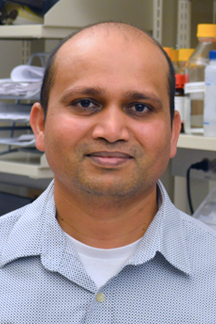Team Discovers New Compounds with Potential to Treat Persistent Tuberculosis
By Eric Sauter
Tuberculosis has been infecting humans for several millennia, making it one of the most horribly successful diseases in history. Today, it is still a major killer, responsible for some 1.5 million deaths each year.
In a substantial number of cases—some two billion, in fact—the tuberculosis bacteria (Mycobacterium tuberculosis) isn’t active at all. Instead, it hides inside cell aggregates, latent and persistent, waiting to break out.
Now, scientists from the Florida campus of The Scripps Research Institute (TSRI) have discovered several first-in-class compounds that target these hidden infections by attacking a critical process the bacteria use to survive in the hostile environment of the lungs.
The study, which was published recently online ahead of print by the journal ACS Chemical Biology, was led by Kate Carroll, a TSRI associate professor.
“With the help of Scripps Florida’s high-throughput screening facility, we looked at nearly 40,000 compounds before we uncovered these new, potent inhibitors that attack an enzyme critical to the survival of persistent tuberculosis,” Carroll said. “Thanks to our collaborators in India with access to drug-resistant patient isolates, we were able to demonstrate that these compounds also show excellent activity against multidrug resistant (MDR) and extensively drug-resistant (XDR) strains, in addition to the standard laboratory reference strain, H37Rv, of M. tuberculosis.”
In 2013, the World Health Organization reported that nearly a quarter of all new and previously treated cases of the disease were multidrug resistant—difficult to diagnose and even more difficult to treat.
James Collins, who is the Termeer Professor at the Massachusetts Institute of Technology (MIT) and the Broad Institute of MIT and Harvard University, praised the new study, saying, “This is a marvelous work and an important contribution to the field.”
A Promising New Target
The study identified at least three different structural classes of compounds known as APSR inhibitors active against the bacteria, particularly those multidrug-resistant and extensively drug-resistant strains. The APSR enzyme is essential to the production of reduced sulfur compounds needed to stabilize the cellular environment—and the target of Carroll’s new inhibitors, which aim to kill persistent tuberculosis by disrupting this balance.
“M. tuberculosis infects host macrophages,” Carroll said. “These immune cells produce high levels of reactive oxygen and reactive nitrogen species (RONS), which cause oxidative damage to biomolecules, such as lipids, proteins and DNA. For this reason, M. tuberculosis depends heavily upon the production of RONS-neutralizing reduced sulfur compounds, including mycothiol and cysteine. This is why the reductive sulfur assimilation pathway is such a powerful target. Once you reduce the level of reduced sulfur compounds, you eliminate a central mechanism that all bacteria, including M. tuberculosis, use to survive host defense systems.”
The new study may encourage exploration of this pathway as a target for development of other antibacterial treatments.
"The first-in-class inhibitors in our study satisfy many criteria expected of a lead scaffold for anti-tuberculosis therapeutics,” said Prakash Palde, the first author of the study and a research associate in the Carroll lab. “But the presence of APSR enzyme in other pathogenic bacteria also means our new inhibitors may have the potential to be developed in to a class of broad-spectrum antibiotics.”
In addition to Carroll and Palde, other authors of the study, “First-In-Class Inhibitors of Sulfur Metabolism with Bactericidal Activity against Non-Replicating M. tuberculosis,” include Laura E. Pedró Rosa, Franck Madoux, Peter Chase, Vinayak Gupta, Timothy Spicer and Louis Scampavia of TSRI; and Ashima Bhaskar and Amit Singh of the Indian Institute of Science, Bangalore, India. For more information, see http://pubs.acs.org/doi/abs/10.1021/acschembio.5b00517
The work was supported by the National Institutes of Health (grant number GM087638), the Ministry of Science and Technology, India (BT/PR5020/MED/29/454/2012), and the Wellcome-DBT India Alliance (500034/Z/09/Z).
Send comments to: press[at]scripps.edu















